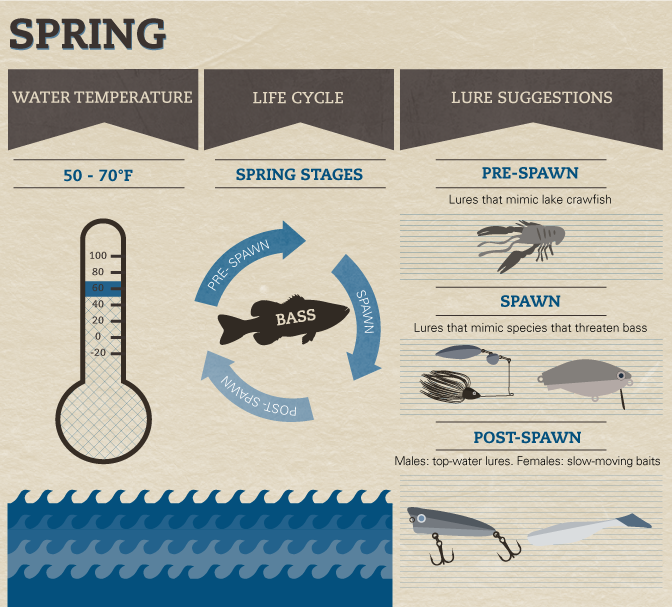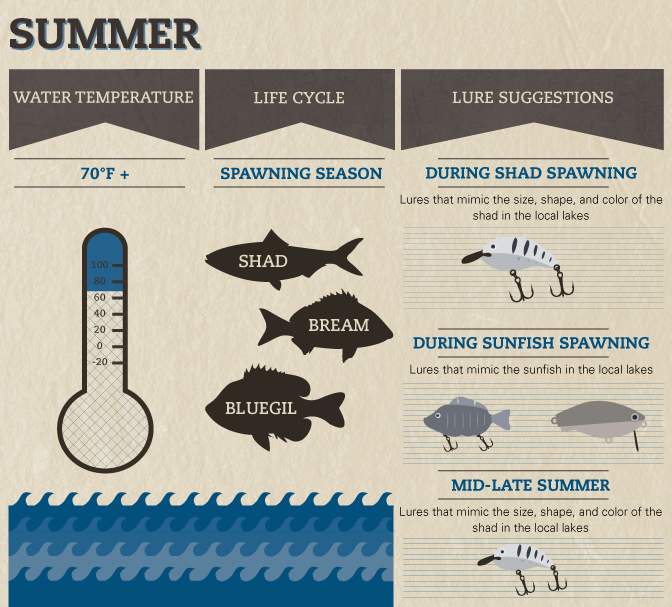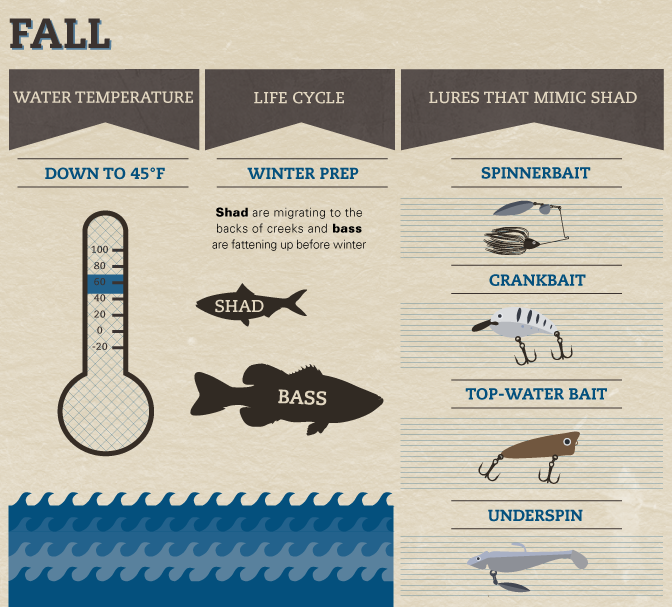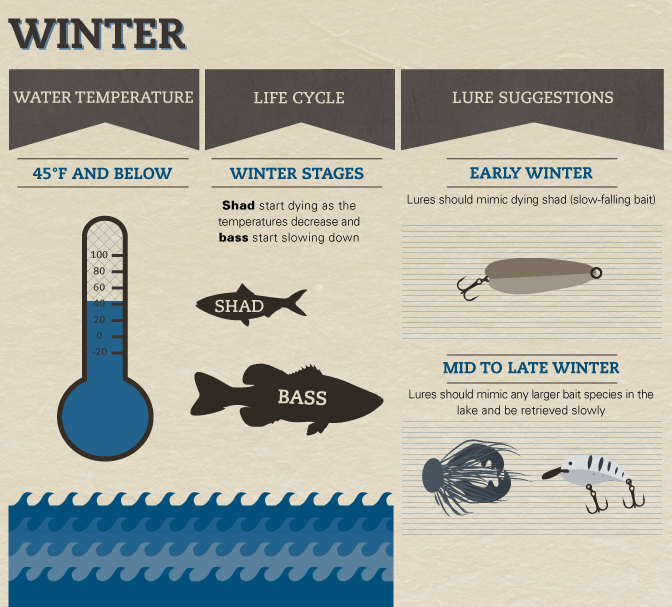Would you rather have a box of random baits or would you prefer to receive one containing baits that are specific to the seasonal feeding habits of bass? At MONSTERBASS we make an effort to create boxes that provide you with the baits you need for the fishing conditions you're faced with.
Each month our team takes the seasonal feeding habits of bass and then determines what stage in the season that each of our regions is facing and then customizes a box specifically for you. Doing so insures that the baits will send you will give you the greatest chance of catching fish.
Let me simplify this... If you live in Michigan, do you want me sending you a box full of topwater baits in the month of February? Probably not. Our competitors actually do this. Why you might ask? Simple... because it's a lot easier to send a box of random baits than it is to create customized boxes specific to the places that you live and fish.
Let's break down the seasons into detail to further explain my MONSTERBASS is a premium fishing subscription so we can show you exactly why it is #thebetterbox
Spring into Action
There are three stages to a bass’s life cycle in the spring: pre-spawn, spawning, and post-spawn. Each stage has its own available forage. When the temperatures begin to rise, a bass’s metabolism speeds up and it needs more food to survive. During spring, all species of fish start moving toward shallow bays and north- or west-facing bank lines to capture the sun’s warmth. Larger baitfish that survived the winter limit the available food sources for bass. Shad, minnows, bream/bluegill, and other smaller species are all primary targets for bass. In spring, bass are not picky eaters and devour anything available. Presenting larger baits better mimics the available forage size.
Pre-Spawn: As spring advances, bass start preparing for the spawning season. Bass feed heavily prior to the spawning ritual because they know that during the 10 to 14 days of spawning they will not feed at all. As the water warms above 50 degrees, bass change their primary forage to a high-protein diet. This helps egg development in females. Because of the protein content, crawfish are a highly sought-after food source during pre-spawning. Lures that have the size and color of lake crawfish species are the best options for mimicking what the bass search for during this time of year.
Spawn: During the spawning phase, a bass’s attitude changes, becoming defensive. Bluegill, bream, crawfish, salamanders, and even small turtles will attack a bass’s nest. Bass will aggressively assault these species, not for food but as a threat. First, a bass will try and run these pillagers away from the nests. If an invader returns, the bass will kill it. Anglers should choose baits that imitate these species that threaten bass eggs.
Post-Spawn: The last phase in the spring cycle is the post-spawn. In this cycle, the females leave the males to guard the fry. The majority of the female bass can be found in deeper water, resting from the spawning ritual. The males will stay near the nests, protecting the recently hatched fry. Bait options vary depending on whether you target male or female bass. To target male bass guarding fry along the shorelines, use top-water baits. The fry stay very shallow and near the surface, so the male bass protecting them swim just beneath and attack anything that poses a threat to the fry. Surface baits that make noise and scare the fry become an immediate enemy of the male bass.
Female bass migrate to slightly deeper water; although they are healing from the spawn, they are very hungry. Just about any bait that’s slow is a good choice. By now the water has warmed significantly and the shad in the lake will migrate to the shallows for their own spawning season. Their migration intersects with females moving toward deeper water, and the shad become a primary food source as the two fish cross paths.
After the bass spawning cycle is complete in spring, the tables turn and the bass becomes the predator again. As the water continues to warm, other species begin spawning cycles. Bass utilize these spawning species to their advantage for easy feeding opportunities.
As the water temperature gets to about 70 degrees, shad start to spawn; this typically occurs about two or three weeks after the bass spawn. When shad follow a bait to the boat, that’s a telltale sign of shad spawn. That signifies male shad looking for a female mate. At the water’s edge, you will also notice small groups of shad chasing each other around items such as rocks, dock pylons, vegetation, or any debris in the water. This is how they spawn.
I like to call the shad spawn Mother Nature’s way of fattening up the bass after they have spawned. Hungry bass gorge themselves on this abundant food source in the shallow waters. Once you notice the shad spawn, choose baits that mimic the same size, shape, and color of the shad in your local lakes. Silver or white baits with a green or blue hue are very effective.
Bream, bluegill, and other sunfish species start their spawning rituals after the shad spawn. You’ll see this by locating small, cleared-out circles cleared on the bottom of shallow pockets. A good bream/bluegill bedding ground will have 20-50 of these circles inside a 20-yard square. Large bass prowl the edges of these spawning grounds, waiting for weak or tired bream/bluegill to swim by. These species have a tremendous color variance across the country. It is important to investigate the local waters to best match the colors of the species. During this phase, bait choices should mimic the bream or small sunfish in your area.
Summer Lovin’
As the season moves into mid-summer, forage opportunities for bass open up, consisting of everything from shad that have migrated back to deeper waters to bream/bluegill that live in shallow water most of the year and crawfish that are plentiful in all lake depths. As summer progresses, shallow waters become extremely warm and bass seek deeper water for cooler temperatures. Bass use creek channels, ledges, deep grass lines, or points to migrate in search of shad. Finding one of these structures and presenting baits that mimic shad will increase your chances of landing bass.
Falling for it
In autumn, the water cools down and everything in the lake seems to migrate to the backs of creek channels. As the fall rains wash nutrients from summer growth into the lake, these nutrients trigger plankton explosions. Shad, in search of this food source, migrate towards incoming water. Your lake’s larger feeder creeks fill up with shad and the bass are never far behind. Bass use the fall shad migration as a means to fatten up for the winter. This time of year bait choices are nearly unlimited. Bass aggressively feed and eat anything that resembles a shad. Spinnerbaits, crankbaits, and top-water baits all allow you to cover a lot of water and draw violent strikes from bass.
As the water temperatures continue to decrease in winter, forage starts to die off. These dying species become prime targets for bass. Most shad species cannot survive when the water temperatures fall below the mid-40s: they become easy meals for bass. This time of year, if you find shad, you find bass. Use baits that fall through and around shad. The slow-falling bait mimics a dying shad and bass aggressively strike.
Baby, It’s Cold Outside!
Once winter has a firm grip, feeding opportunities for bass become slim. Cold-blooded bass are the same temperature as their surroundings. The bass’s metabolism slows tremendously and they don’t need to feed as often, which means they’re difficult to catch. The available food sources are the largest of the forage species that survive the cold. Your best chance is to mimic any species in the lake with larger bait and a very slow retrieve.
As an angler, there are some general feeding habit rules that should be considered. First and foremost: bass are opportunistic feeders. When presented with an easy meal and the energy used to capture it is less than the energy gained from eating it, the bass sees this as a benefit and takes the opportunity to eat. Second: there are geographic feeding habits that can’t be ignored. An example is the West Coast. Bass have adapted to eating the trout that are stocked in lakes; this forage has to be considered when fishing lakes stocked with any kind of fingerlings. Lastly: crawfish are in every lake, river, and stream, making them available, year-round forage. When choosing baits that mimic crawfish, pay close attention to water temperature. The colder the water, the slower your presentation.
By knowing the feeding habits of bass, anglers can present a bait choice that the bass seek out. Choose baits that mimic the size and color of the forage bass are feeding on for the season. There are many keys to a successful day on the water and using the proper bait starts you in the right direction
So now that you know all of this... let me ask you again. Would you rather sign up to a receive a box of random baits each month like our competition sends you or would you prefer a box of baits that are hand selected to match the fishing conditions you're facing right now?
If your answer is a box of baits that are hand selected to match the fishing conditions you're facing right now... then sign up today and use code SAVE10 to save $10 off your first order. I guarantee you'll like it.
Cheers.
Rick
Source: Fix.com
← Older Post Newer Post →






